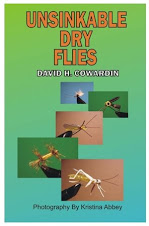The
Dream Salmon Fly
I’m going to show you how to tie a Salmon Fly that will out
perform all others simply because it presents right profile and size. Stop here if you are not into different
materials because this fly is definitely non-traditional and the main body is
not tied but assembled. This fly floats like a cork and is impossible
to sink always popping to the surface even in the roughest of water.
The
ideal fly is 2 ½ to 3 inches long (6-8 Centimeters)
The
materials are as follows:
Hook – size
2-6 any brand 4-6x long with as light of wire as possible
Thread
- brown and metallic orange
Body – ¼ inch colored
or UV reactive orange heat shrink or orange latex tubing
Head – ¼ inch gray polyethylene closed cell foam
Wing -
home made wing material with black netting and some type of sparkle (follow
this link to see how to make https://unsinkableflies.blogspot.com/2012/02/making-fly-wing-material-fly-tying.html)
Antenna
– brown monofilament
Legs - brown rubber
Eyes - black mono or vinyl
Egg Sack – ¼ inch round black foam
Collar - brown saddle (optional)
Shown in the
pictures above are the materials to be used and a 15 watt soldering iron used
to segment the heat shrink fly body. Note the two body materials the top
one is orange UV Heat Shrink and the one below the top one is the colored heat
shrink.
The heat shrink bodies above have been segmented and
assembled prior to attachment to the hook.
If the body is latex segmenting is performed by pulling the thread
tightly around the hook shank. The egg sack and head is super glued into
place along with shrinking with the soldering iron. The eyes shown are
super glued into place..
Directions:
- Wrap the
hook shank with brown thread.
- At the rear
of the hook tie in the assembled fly body (6-10 wraps).
- Tie in the
rear legs (location of legs varies depending on amount of segments).
- Work you way
up the hook shank applying 6-10 wraps at each segment and tie in the
middle legs.
- Near the eye
tie in the tie in the front legs.
- Whip finish
at the eye with the brown thread.
- Tie in the metallic
orange thread at the first or second front segment.
- Attach the
wing or wings (1 to 3 depending on the fly).
- Whip finish
with the metallic orange thread and apply a small amount of head cement or
super glue long the hook shank.
This will stabilize the body and keep it from rotating on the hook
shank.
- Under side of finished fly.






